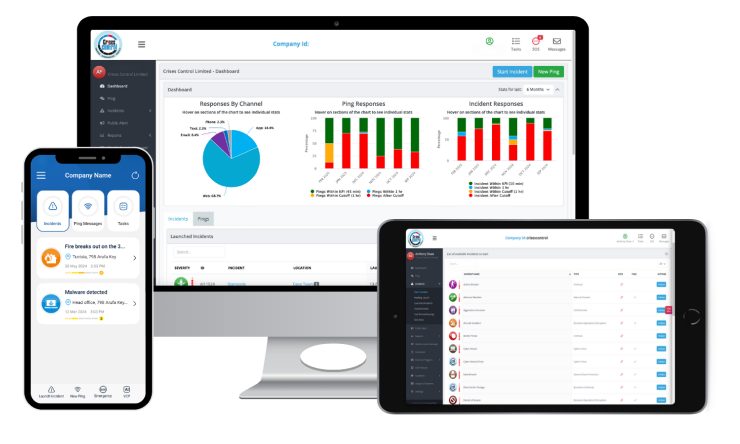Written by Anneri Fourie | Crises Control Executive
Trust can take years to build and only minutes to damage. For technology companies, one technical fault can shake that trust in an instant. A server can fail during a high-profile product launch, an application may stop working at peak usage, or a security issue might expose sensitive data. These are not just technical problems. They affect customer confidence, reputation and revenue.
Downtime creates uncertainty. Customers expect clear information, employees look for guidance, and stakeholders want a structured plan. Silence or slow communication makes the situation worse. This is where Crisis Communication Software can change the outcome. Proactive and transparent communication during incidents builds trust, reduces confusion and helps companies protect their reputation even in challenging moments.
Why Crisis Communication Software Is a Game Changer for Tech Companies
For technology businesses, clear communication during incidents can be just as critical as fixing the technical issue itself. A delay in updates or unclear messaging can turn a disruption into a full-blown crisis. Crisis Communication Software gives companies a structured way to share information during outages, security breaches or system failures.
Unlike traditional messaging channels, this type of software can send real-time notifications to the right people, track acknowledgements and make sure messages are not missed. Fast and accurate communication can make the difference between a short disruption and a reputation problem that lasts.
Tech companies operate in environments where users rely on uninterrupted digital services. When things go wrong, people want timely updates and transparency. Quick, honest communication reassures customers, prevents speculation and shows control when it is needed most.
How Downtime Damages Trust
When systems fail, the damage goes far beyond the technical issue. A single hour of downtime can cost money, time and confidence. Trust begins to slip the moment silence sets in.
- Customers lose confidence when they are left without clear updates.
- Staff are unsure how to respond if communication is not coordinated.
- Stakeholders become concerned if there is no clear plan of action.
- Reputational damage grows the longer communication is delayed.
A company that stays silent during an incident gives the impression of disorganisation. On the other hand, a company that communicates quickly and clearly can maintain customer trust, even when the problem itself takes time to fix.
Building Confidence with Crisis Communication Software
Crisis Communication Software creates a direct line between IT teams, leadership, customers and stakeholders. Instead of trying to draft messages in the middle of a crisis, teams can activate pre-defined communication plans in seconds.
This means:
- The right teams are alerted without delay.
- Customers receive accurate updates at the right time.
- Stakeholders can follow progress without asking for it.
- Communication logs are stored automatically for review later.
One technology company uses Crises Control to launch communication protocols during live operations. IT, security and operational teams receive instant notifications and respond together, while customers are updated clearly and promptly. Another organisation runs regular communication tests through the platform, making sure workflows are ready before an incident happens. In both cases, preparation and structured communication help build trust when pressure is high.
Best Practices for Incident Communication in Tech Firms
Clear, fast and structured communication can protect a company’s reputation when systems fail. These best practices can help tech organisations manage incidents more effectively.
1. Act Quickly with Real-Time Notifications
Speed matters when something goes wrong. Real-time notifications make sure the right people receive alerts without delay. Whether the issue is a service outage, infrastructure fault or security alert, early communication prevents confusion and shortens recovery time.
2. Create Transparent Communication Plans
People prefer clarity over silence. A well-defined plan that explains who to inform, how to share updates and when to escalate allows teams to respond with confidence. Pre-approved messages reduce hesitation and keep communication consistent.
3. Segment Your Audiences
Not everyone needs the same level of detail. Internal teams, customers and partners require different types of updates. Segmenting communication ensures each group receives relevant information without being overloaded.
4. Be Consistent Across Channels
When messages differ across email, SMS, apps or other platforms, trust erodes. Crisis Communication Software helps maintain consistency so that everyone receives the same information, no matter how they access it.
5. Follow Up and Close the Loop
Communication does not end once the system is back online. A clear follow-up message that explains what happened, how it was resolved and what will be done to prevent it in the future helps rebuild trust after downtime. Transparency leaves a lasting impression.
Rebuilding Trust After Downtime
Even the most reliable technology can experience failures. What matters most is how companies respond. When communication is structured, fast and transparent, incidents become opportunities to reinforce trust instead of eroding it.
When customers receive quick and accurate updates, they remain confident. When staff have clear information, they can act effectively. When stakeholders see a structured communication process, they trust that the company can handle challenges with professionalism.
Rebuilding trust is not achieved through a single statement. It is earned through consistent communication and accountability throughout the entire incident.
Features That Strengthen Communication in a Crisis
The right Crisis Communication Software can transform how tech organisations handle incidents. Key features to look for include:
- Real-time notifications to reduce delays and alert the right people immediately.
- Pre-defined workflows that remove uncertainty during critical moments.
- Multi-channel delivery through email, SMS, voice calls and mobile notifications.
- Customisable groups to target the right audiences.
- Incident tracking and reporting to review performance after the event.
- Integration with existing IT systems to keep operations seamless.
These features help companies communicate with clarity and consistency when it matters most. They also support continuous improvement by making it easy to review and refine processes after each incident.
How Crises Control Helps Tech Companies Build Trust
Crises Control provides a communication platform designed to support technology companies during outages, security incidents and system failures. The software focuses on real-time alerts, structured workflows and clear messaging, all of which are essential to maintaining trust during difficult moments.
With Crises Control, tech companies can:
- Send targeted messages to the right teams and stakeholders.
- Keep customers informed with accurate and timely updates.
- Coordinate IT and security responses more effectively.
- Track communication for post-incident analysis and compliance.
- Build trust through transparency and reliability.
Many organisations with complex technology environments rely on Crises Control to keep teams connected, reassure customers and protect their reputation when incidents occur.
Creating a Culture of Trust Through Communication
Technology incidents will happen, no matter how advanced the systems are. The difference between a temporary setback and lasting reputational harm is communication. Companies that communicate openly, clearly and consistently are the ones that earn trust and keep it.
Investing in Crisis Communication Software is not just about responding faster. It is about taking responsibility, protecting relationships and showing that the company is in control. Over time, this approach strengthens brand reputation and builds loyalty with customers, staff and partners.
Take the Next Step
If your company wants to strengthen trust during incidents, proactive communication is the key. Crises Control offers a solution designed to help technology organisations communicate clearly, send real-time notifications, and maintain control when problems arise.
Contact Crises Control today to book a free demo and see how your organisation can build trust, protect its reputation and keep customers and teams informed when it matters most.
Request a FREE Demo

